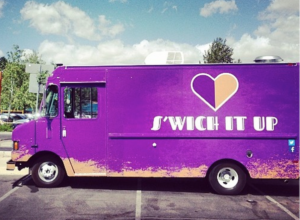Πηγαίνετε εκτός σύνδεσης με την εφαρμογή Player FM !
4 Unique Ways This Food Truck Owner Funded His Business
Manage episode 443045713 series 1539985
In the third installment of our series, we sit down with Anthony Salvagno, the entrepreneurial mind behind S’wich It Up, to discuss the creative mix of funding sources he used to bring his food truck dream to life. Like many food truck owners, Salvagno didn’t have a one-size-fits-all solution to financing. Instead, he pieced together funds from personal savings, a business plan competition, crowdfunding, family contributions, and a loan. This cocktail of resources gave him the capital he needed to roll out his business.
“Crowdfunding is like a whole different beast when it comes to raising money,” Salvagno reflects. “You’re basically marketing your business full-time. It’s an 8-hour-a-day job, and you’re trying to do everything you can to raise awareness.” For Salvagno, this was just one slice of the larger funding pie.
The Reality of Traditional Loans
Getting a traditional business loan for a new food truck is tough. Banks typically want a track record, something new businesses rarely have. For Salvagno, the concept of S’wich It Up was still unproven, and with no revenue history, traditional banks were off the table.
“Like any new business, it’s an untested idea at this point and has no history of revenue generation,” Salvagno explained during our interview. “Getting a traditional business loan from a bank is not going to be an option for most entrepreneurs.”
Fortunately, Salvagno found alternatives in his hometown of Albuquerque, New Mexico. He tapped into Wesst and The Loan Fund, nonprofit organizations designed to help local entrepreneurs secure funding. Through The Loan Fund, Salvagno secured $25,000. “This loan made all the difference in helping us get started,” he says.
If you’re launching your own business, Salvagno’s advice is clear: research the local nonprofit organizations in your area. Many cities across the U.S. offer similar programs to support small businesses and stimulate the local economy.
The Breakdown: How to Fund a Food Truck
Salvagno’s total target for his food truck was $40,000. But as most entrepreneurs will tell you, costs quickly grow, and that number inflated to $55,000 when factoring in additional fees and unexpected expenses. Here’s how he pieced together the funding:
Personal Savings: $15,000
Salvagno, like many entrepreneurs, had to dip into his personal savings to jump-start his business. This initial seed capital gave him the flexibility to begin serious planning.
Business Plan Winnings: $5,000
Salvagno entered a business plan competition and walked away with a $5,000 prize. It wasn’t just the money that helped—it was the validation. Winning a competition built credibility and gave him momentum.
Family Contributions: $5,000
“Thanks, Mom!” Salvagno chuckled during the interview, acknowledging the $5,000 loan he received from family. It’s not uncommon for food truck owners to rely on family for financial support when starting out. In Salvagno’s case, it helped bridge the gap in his funding.
Crowdfunding Campaign: $5,000
Salvagno ran a crowdfunding campaign that raised $5,000, but it wasn’t as easy as it sounds. “Crowdfunding is a whole job by itself,” Salvagno says. The process of promoting his campaign felt like full-time work, requiring constant outreach and updates to backers. Crowdfunding, he explained, is often misunderstood. People tend to think it’s free money, but you have to provide value—whether through rewards, updates, or simply by keeping your backers engaged.
Business Loan: $25,000
Through The Loan Fund, a nonprofit that supports local businesses, Salvagno secured a $25,000 loan. “It wasn’t everything I needed, but it was what I could get, and it helped me move forward.” The Loan Fund specializes in working with entrepreneurs who can’t get traditional financing, a common hurdle for first-time business owners.

The S’wich It Up Food Truck in all her glory.
The Realities of Crowdfunding
Crowdfunding, at first glance, seems like the golden ticket for many aspiring entrepreneurs. Platforms like Kickstarter and Indiegogo promise a way to raise money from supporters without needing a loan or giving away equity. But for food truck owners like Salvagno, the reality is a little more complicated.
“People think it’s free money, but you really have to work for it,” Salvagno explained during our conversation. That’s because crowdfunding isn’t just about collecting donations—it’s about delivering on promises made to backers. In Salvagno’s case, that meant offering rewards to those who contributed to his campaign. One of those rewards? Handcrafted jars of jellies and butters made by the S’wich It Up team.
“We wanted to give people something special in return,” Salvagno said. It was a great way to connect with supporters, but it also introduced a whole new set of challenges. Not only did they have to produce the jellies and butters—which required time and effort—but they also had to cover shipping costs to get these items into the hands of their backers. And, of course, the more successful the campaign, the more rewards they had to produce and ship.

Just another day on the S’wich It Up food truck.
Crowdfunding platforms themselves also take a cut of the money raised, often between 5-8%, depending on the platform. Then, there’s the cost of creating and fulfilling rewards like Salvagno’s jellies and butters. These costs quickly add up, eating into the total funds raised and, in some cases, leaving far less to invest in the actual business than originally expected.
“It’s easy to forget that when you’re raising $5,000, you’re not keeping all of it,” Salvagno said. “You’ve got platform fees, reward costs, shipping costs—it all adds up. And then there’s the time commitment. You’re spending hours every day updating backers, promoting your campaign, and making sure everything runs smoothly.”
For Salvagno, this meant dedicating several hours a day, often more, to managing the campaign. It was essentially a second full-time job, and it wasn’t over when the funding goal was reached. After the campaign ended, Salvagno and his team still had to fulfill all the rewards they had promised, which extended the workload for weeks. “Crowdfunding is like marketing your business full-time,” Salvagno reflected. “It’s an 8-hour-a-day job.”
This experience sheds light on one of the biggest misconceptions about crowdfunding: it’s not just about raising money, it’s about delivering value in return. For entrepreneurs thinking about crowdfunding, Salvagno’s story serves as both a warning and a lesson in perseverance.
Turning a Dream into Reality
For others looking to start a food truck, Salvagno’s advice is simple: “Do your homework.” Research local organizations that can help you, like Wesst and The Loan Fund, which specialize in lending to small businesses. He also stresses the importance of tapping into your network for support. “Don’t be afraid to ask friends or family for help,” Salvagno says. “Every little bit helps when you’re turning a dream into reality.”
While Salvagno’s journey wasn’t without its challenges, the combination of personal savings, business competition winnings, crowdfunding, and a loan allowed him to pull together the $55,000 needed to launch S’wich It Up. His story is a reminder that building a business takes creativity, hustle, and sometimes a little help from those closest to you.
What You’ll Learn in the Episode
- How a real food truck has successfully acquired funding.
- What Salvagno would do differently with his next crowd funding campaign.
- Some of the misconceptions of crowd funding: Primarily people think that they are giving your “free” money with no value exchange.
- How to find organizations in your area that offer small business loans.
- Why supportive friends and family members can be an important way to help start a business.
Leave us a review on iTunes. You could get featured on the show!
The post 4 Unique Ways This Food Truck Owner Funded His Business appeared first on Food Truck Empire.
14 επεισόδια
Manage episode 443045713 series 1539985
In the third installment of our series, we sit down with Anthony Salvagno, the entrepreneurial mind behind S’wich It Up, to discuss the creative mix of funding sources he used to bring his food truck dream to life. Like many food truck owners, Salvagno didn’t have a one-size-fits-all solution to financing. Instead, he pieced together funds from personal savings, a business plan competition, crowdfunding, family contributions, and a loan. This cocktail of resources gave him the capital he needed to roll out his business.
“Crowdfunding is like a whole different beast when it comes to raising money,” Salvagno reflects. “You’re basically marketing your business full-time. It’s an 8-hour-a-day job, and you’re trying to do everything you can to raise awareness.” For Salvagno, this was just one slice of the larger funding pie.
The Reality of Traditional Loans
Getting a traditional business loan for a new food truck is tough. Banks typically want a track record, something new businesses rarely have. For Salvagno, the concept of S’wich It Up was still unproven, and with no revenue history, traditional banks were off the table.
“Like any new business, it’s an untested idea at this point and has no history of revenue generation,” Salvagno explained during our interview. “Getting a traditional business loan from a bank is not going to be an option for most entrepreneurs.”
Fortunately, Salvagno found alternatives in his hometown of Albuquerque, New Mexico. He tapped into Wesst and The Loan Fund, nonprofit organizations designed to help local entrepreneurs secure funding. Through The Loan Fund, Salvagno secured $25,000. “This loan made all the difference in helping us get started,” he says.
If you’re launching your own business, Salvagno’s advice is clear: research the local nonprofit organizations in your area. Many cities across the U.S. offer similar programs to support small businesses and stimulate the local economy.
The Breakdown: How to Fund a Food Truck
Salvagno’s total target for his food truck was $40,000. But as most entrepreneurs will tell you, costs quickly grow, and that number inflated to $55,000 when factoring in additional fees and unexpected expenses. Here’s how he pieced together the funding:
Personal Savings: $15,000
Salvagno, like many entrepreneurs, had to dip into his personal savings to jump-start his business. This initial seed capital gave him the flexibility to begin serious planning.
Business Plan Winnings: $5,000
Salvagno entered a business plan competition and walked away with a $5,000 prize. It wasn’t just the money that helped—it was the validation. Winning a competition built credibility and gave him momentum.
Family Contributions: $5,000
“Thanks, Mom!” Salvagno chuckled during the interview, acknowledging the $5,000 loan he received from family. It’s not uncommon for food truck owners to rely on family for financial support when starting out. In Salvagno’s case, it helped bridge the gap in his funding.
Crowdfunding Campaign: $5,000
Salvagno ran a crowdfunding campaign that raised $5,000, but it wasn’t as easy as it sounds. “Crowdfunding is a whole job by itself,” Salvagno says. The process of promoting his campaign felt like full-time work, requiring constant outreach and updates to backers. Crowdfunding, he explained, is often misunderstood. People tend to think it’s free money, but you have to provide value—whether through rewards, updates, or simply by keeping your backers engaged.
Business Loan: $25,000
Through The Loan Fund, a nonprofit that supports local businesses, Salvagno secured a $25,000 loan. “It wasn’t everything I needed, but it was what I could get, and it helped me move forward.” The Loan Fund specializes in working with entrepreneurs who can’t get traditional financing, a common hurdle for first-time business owners.

The S’wich It Up Food Truck in all her glory.
The Realities of Crowdfunding
Crowdfunding, at first glance, seems like the golden ticket for many aspiring entrepreneurs. Platforms like Kickstarter and Indiegogo promise a way to raise money from supporters without needing a loan or giving away equity. But for food truck owners like Salvagno, the reality is a little more complicated.
“People think it’s free money, but you really have to work for it,” Salvagno explained during our conversation. That’s because crowdfunding isn’t just about collecting donations—it’s about delivering on promises made to backers. In Salvagno’s case, that meant offering rewards to those who contributed to his campaign. One of those rewards? Handcrafted jars of jellies and butters made by the S’wich It Up team.
“We wanted to give people something special in return,” Salvagno said. It was a great way to connect with supporters, but it also introduced a whole new set of challenges. Not only did they have to produce the jellies and butters—which required time and effort—but they also had to cover shipping costs to get these items into the hands of their backers. And, of course, the more successful the campaign, the more rewards they had to produce and ship.

Just another day on the S’wich It Up food truck.
Crowdfunding platforms themselves also take a cut of the money raised, often between 5-8%, depending on the platform. Then, there’s the cost of creating and fulfilling rewards like Salvagno’s jellies and butters. These costs quickly add up, eating into the total funds raised and, in some cases, leaving far less to invest in the actual business than originally expected.
“It’s easy to forget that when you’re raising $5,000, you’re not keeping all of it,” Salvagno said. “You’ve got platform fees, reward costs, shipping costs—it all adds up. And then there’s the time commitment. You’re spending hours every day updating backers, promoting your campaign, and making sure everything runs smoothly.”
For Salvagno, this meant dedicating several hours a day, often more, to managing the campaign. It was essentially a second full-time job, and it wasn’t over when the funding goal was reached. After the campaign ended, Salvagno and his team still had to fulfill all the rewards they had promised, which extended the workload for weeks. “Crowdfunding is like marketing your business full-time,” Salvagno reflected. “It’s an 8-hour-a-day job.”
This experience sheds light on one of the biggest misconceptions about crowdfunding: it’s not just about raising money, it’s about delivering value in return. For entrepreneurs thinking about crowdfunding, Salvagno’s story serves as both a warning and a lesson in perseverance.
Turning a Dream into Reality
For others looking to start a food truck, Salvagno’s advice is simple: “Do your homework.” Research local organizations that can help you, like Wesst and The Loan Fund, which specialize in lending to small businesses. He also stresses the importance of tapping into your network for support. “Don’t be afraid to ask friends or family for help,” Salvagno says. “Every little bit helps when you’re turning a dream into reality.”
While Salvagno’s journey wasn’t without its challenges, the combination of personal savings, business competition winnings, crowdfunding, and a loan allowed him to pull together the $55,000 needed to launch S’wich It Up. His story is a reminder that building a business takes creativity, hustle, and sometimes a little help from those closest to you.
What You’ll Learn in the Episode
- How a real food truck has successfully acquired funding.
- What Salvagno would do differently with his next crowd funding campaign.
- Some of the misconceptions of crowd funding: Primarily people think that they are giving your “free” money with no value exchange.
- How to find organizations in your area that offer small business loans.
- Why supportive friends and family members can be an important way to help start a business.
Leave us a review on iTunes. You could get featured on the show!
The post 4 Unique Ways This Food Truck Owner Funded His Business appeared first on Food Truck Empire.
14 επεισόδια
Toate episoadele
×Καλώς ήλθατε στο Player FM!
Το FM Player σαρώνει τον ιστό για podcasts υψηλής ποιότητας για να απολαύσετε αυτή τη στιγμή. Είναι η καλύτερη εφαρμογή podcast και λειτουργεί σε Android, iPhone και στον ιστό. Εγγραφή για συγχρονισμό συνδρομών σε όλες τις συσκευές.





